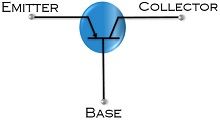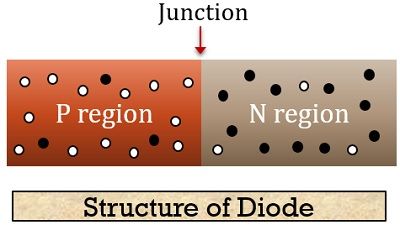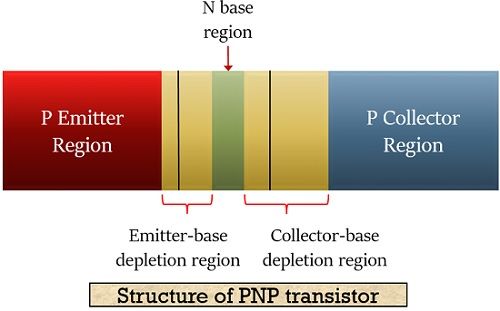Both diode and transistor are semiconductor devices and are the major part of electronic circuitry. However, there exist several differences between the two. The major difference between diode and transistor is that a diode is a 2 terminal device formed by merging p and n-type semiconductor material. As against, the transistor is a 3 terminal device formed by placing p or n-type semiconductor between two similar semiconductor material having opposite polarity as that of the placed material. For example, PNP or NPN transistor.
Let’s have a look at the contents to be discussed under this article, then we will move further and discuss other important differences between the diode and transistor.
Content: Diode Vs Transistor
Comparison Chart
| Parameter | Diode | Transistor |
|---|---|---|
| Definition | A semiconductor device that has the ability to allow current flow unidirectionally. | A semiconductor device that has the ability to allow current flow from a region of high resistance to low resistance. |
| Symbolic representation |  |  |
| Operating mode | Forward and reverse bias. | Active, cutoff and saturation mode. |
| Terminals | 2 terminals | 3 terminals |
| Number of depletion region | Only 1 depletion region is present due to single junction. | 2 depletion region are present due to 2 junctions. |
| Supply required | Single battery source is required. | It essentially requires 2 batteries. |
| Controllability | Do not exist | Exist As load current is controlled by applied potential at the base. |
| Used as | Switch | Switch and amplifier |
| Applications | In rectifier circuits, detector circuits, clippers and clampers circuits. | In amplifier and oscillator circuit. |
Definition of Diode
A diode is a semiconductor device that is formed by the combination of p and n-type semiconductor material. The diode permits current to flow in only single direction. The basic form of the diode is a PN junction diode. However, there exist several types of diodes such as zener diode, tunnel diode, a PIN diode, LED etc.
The figure shown below will help you to understand the structure of the diode more easily:

Here, a p-type semiconductor material having majority carrier holes is fused with an n-type semiconductor material having majority carrier electrons. The junction of the two materials forms depletion region that contains neutral atoms. However, its operation is different in an unbiased and biased state. And at the time of providing biasing it can be either forward biased or reverse biased.
When no any potential is applied across its terminals then it is said to be the unbiased state. At the unbiased state flow of carriers take place due to temperature variation. But after a certain point of time, a depletion region is created at the junction because of the recombination of holes and electrons. This depletion region contains neutral atoms. That blocks any further flow of carriers across the junction.
Now we provide biasing to the device. It is noteworthy here that in both forward and reverse applied voltage, the device operates in a different manner.
When a forward voltage is provided then current through the device increases. This is so because majority carriers experience repulsion from the battery terminal. Thereby gaining sufficient energy to surpass the barrier potential of the depletion region.
But in the case of reverse biased condition, the depletion width increases with the increase in applied reverse voltage. Therefore, the current through the device will not show a major increase in it. However, if the reverse applied voltage is increased continuously then it can cause damage to the device.
Definition of Transistor
The transistor comprises 3 regions. It is a device that possesses the ability to allow the flow of current from a region of having high resistance to that of the low resistance. It is a merger of two words transfer and resistor. As it has the ability to transfer the resistance of a device.
A transistor is categorized as either Bipolar Junction Transistor i.e., BJT or Field Effect Transistor i.e., FET. The device holds the property of current controllability.
The figure below represents the structure of a transistor having a PNP configuration:

A transistor can be made either in NPN configuration or PNP configuration. In NPN transistor p region is merged between two n regions whereas in PNP transistor n region is merged between two p regions. In both the configurations their majority carriers will be responsible for current conduction through the device.
Consider the figure shown above of PNP transistor. In unbiased condition two depletion region is created due to the flow of majority carrier because of temperature variation at the junctions of the transistor. These then oppose any further flow of majority carriers within the device.
In the transistor, the 3 terminals, emitter, base and collector functions differently. It is noteworthy here that the emitter-base junction is always provided with forward potential. And the collector-base junction is always provided with reverse potential. The electrons injected from the battery terminal reaches the emitter region. From this particular region, majority carriers move to the base region after overcoming thin depletion region at its junction.
Further, in the base region, only a few majority carriers reaching base combines with the majority carriers of the base region. Rest majority carriers move further to the collector region. Due to which current flows through the device.
Key Differences between Diode and Transistor
- The major factor that differentiates diode and transistor is that a diode allows current flow in only one direction. However, transistor regulates current flow from high resistance to low resistance region.
- A diode operates in forward biased and reverses biased mode. On the contrary, a transistor operates in 3 modes i.e., active, cut-off and the saturation region.
- In diodes, p and n regions are merged that forms a PN junction thus has one depletion region. But transistor has two configurations i.e., PNP and NPN. Due to this, it forms 2 junctions thus it has 2 depletion regions.
- The diode has 2 terminals, the p side shows the anode terminal and the n side shows the cathode terminal. While, the transistor is a 3 terminal device i.e., emitter, base and collector.
- The diode is an uncontrollable device. As against, the transistor is a controllable device as its base applied voltage controls the load current.
- Diodes are majorly used for switching purpose. While transistors are used for amplification and switching purpose.
- Diodes find its applications in rectification, in signal detection, in clippers and clampers etc. However, transistors find its applications in amplifiers and oscillator circuits etc.
Conclusion
So, from the above discussion, we can conclude that a transistor uses the configuration of a diode. As it somewhat resembles like two didoes connection. But we can’t clearly say that it is only two back to back connected diodes. As the 3 terminals of the transistor help to regulate the current flowing through it.